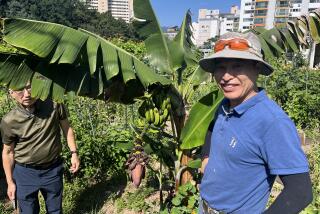Calamondin: Cousin of the kumquat delivers fruit all year
- Share via
The scent of citrus emanating from Boni Liscano’s backyard in Atwater Village comes from a 20-foot-high calamondin tree (Citrofortunella microcarpa), sometimes called kalamansi or calamansi. The tree is covered in small, lime-shaped green fruit that has a thin rind, juicy pulp and distinctive sour flavor. It’s similar to a kumquat (to which it’s related) but has a stronger bouquet -- an aroma that’s sweeter than lemon and more like orange.
Native to the Philippines, calamondin is a wild hybrid used throughout the archipelago in sauces, candies, marinades and drinks. It’s squeezed fresh over fish or rice noodles. Liscano’s wife, Dulce, said she grew up drinking calamondin juice, which also is used as a hair conditioner, a natural anti-freckle bleach or even a way get stains out of jeans.
Calamondin also is popular as a decorative shrub, adaptable to containers and indoors as well. With evergreen foliage and tiny fruit, it can be treated like a big bonsai with color.
Liscano planted his tree in 1981 after picking up a seedling at a Filipino grocery store. After about five years it began producing fruit, and it hasn’t let up since.
Like a kumquat tree, calamondin can bear flowers and fruit in successive waves, all year. The fruit is best harvested when yellowing, tinged with green. If left on the tree too long, it turns tangerine orange and is dry and tasteless.
Gardeners wanting to sample the fruit won’t find it easily -- only at farmers markets or sometimes Filipino markets. Nguyen Tran of Starry Kitchen said calamondin is his latest favorite ingredient. “It’s so smooth,” he said. “When I go to Filipino grocery stores, I don’t find it that often -- in a bottle, carton or as a concentrate, rarely fresh.”
Thus the quest to grow one’s own. How? Calamondin starts easily from seed, but that may not lead to good harvests. The Liscanos’ neighbors have mature calamondin trees that don’t yield fruit. Boni has better luck with the seedling he purchased. He gives the now-grown tree regular water and in return it delivers fruit that is huge compared to that found in the Philippines.
When the tree is churning out fruit heavily, Liscano quickly fills a box to give out at his church.
“I just give them away,” Liscano said. “It comes from the tree. That’s free. If I sell them then God will take away the tree.”
The Global Garden, a look at our multicultural city through the lens of its landscapes, appears here on Tuesdays. For an easy way to follow future installments, join our Facebook page for Gardening in the West. Email: home@latimes.com.
ALSO:
The Global Garden: Ground cherries
The Global Garden: Salsa-ready tomatillos
More to Read
Eat your way across L.A.
Get our weekly Tasting Notes newsletter for reviews, news and more.
You may occasionally receive promotional content from the Los Angeles Times.








